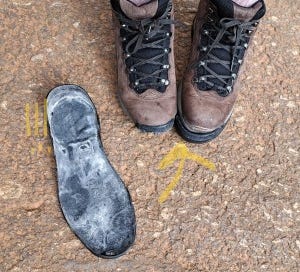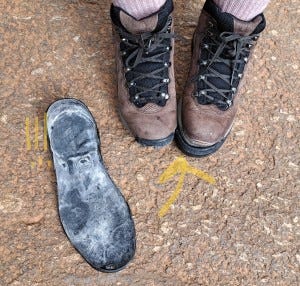Productivity Strategies: Evolving Your Systems for Success
My husband and I recently bought and are slowly restoring a vintage hard-sided pop up camper. The camper is now clean and functional enough to go camping even in the midst of restoration and renovation so we recently took our dogs out for a weekend trip. We enjoyed beautiful almost autumn-like weather for lots of hiking and had a great time as a little family.
Of course, camping trips are rarely without adventure or excitement…
I’ve had my beloved Timberland boots for what must be 20 years now and they kept up great on Saturday morning. Alas…Saturday afternoon was a different story!
After a good laugh and some time considering fixing the shoes, we realized the tread was pretty worn out and maybe replacing them was best. So for the second time in 20 years, I’ve bought hiking boots! If I’d checked the boots more thoroughly before we went on our trip I’d likely have noticed the impending doom ahead, but I trusted the same system was still good. Sometimes our systems hold, sometimes it’s time for a new strategy.
The World’s Most Organized Teen?
When I was a teenager, I had a Dayrunner and it was next-level organized. There was color coding, a pocket with extra tools, and an ability to never miss a school deadline. People were generally amused by this. I was also amused that I seemed to have myself more organized than many adults…

That was really just the earliest days of my efficiency and productivity expertise if I’m honest. I desire systems and function in life to make it run as smoothly as it can. If the mundane things like remembering which day we need to get the garbage to the street don’t occupy space in my mind, than my mind can focus on the things I get to innovate, create, and engage with more meaningfully.
For some, paper calendars are still a vital part of their planning process, but for me, I gave them up many years ago in favor of having my entire system in my pocket or bag when I’m away from home. Having more flexibility these days makes this more vital to me when I’m not maintaining a more traditional schedule.
It’s possible I’ve seen every productivity app out there – at least in reading about them, if not testing them. But my current system relies on my standard approach: digital calendar, digital grocery/other errands app, and Todoist for everything else. (Todoist isn’t perfect but after many years and stops/starts, I still think it’s the best option. More work-specific systems advice here.) My husband and I invite each other to key appointments digitally and we also have a home dry erase calendar to highlight the big stuff for the week. We share Todoist tasks for cleaning, home maintenance, and dog care reminders.
This system is working for now, but I’m willing to revisit it whenever it feels like it’s not. Sometimes our systems hold, sometimes it’s time for a new strategy.
Rage Burning an Embroidery Hoop
Beyond my life as professor, I am deeply in my embroidery era (and sewing…see vintage camper restoration!). I do a variety of needlework, mostly hand embroidery. I started that journey almost seven years ago and have quite a collection of tools of the trade by now. While we were camping, I realized I packed one of my early purchases, a very cheap 10″ embroidery hoop that was not properly holding fabric tension (which is vital).
I did what had to be done:
Sometimes our systems hold, sometimes it’s time for a new strategy.
Determining When to Make a Change
Sometimes the breakdown of a system makes it super obvious – the soles of our shoes come off! More often, we keep using brokenness until we are frustrated to the point of a bigger reaction (like burning an embroidery hoop!). The notion of sunk costs and time matters but we can get too stuck on it, too!
Some time ago, when I was still managing a team, I spent huge amounts of time and energy bringing the full team on Todoist to manage and automate tasks. Other than minor blips, training challenges, and the expected moments of resistance to change, it went great…until it didn’t. At some point, Todoist goofed big and the team functionality suffered mightily with broken tasks, failed comments, and more.
I spent a good bit of my time moving the whole system to Trello, which that team continues to use today. It was a pain, it was not fun, and I was mad (might still be) at Todoist. But that tool was no longer the right tool and we needed a new team strategy. (I still want back to it later personally, so clearly my anger has its limits…) And honestly in some ways Trello worked better for the team, had some features Todoist didn’t, and had options for customization that were really valuable.
I could have asked my team to muddle through the madness of a broken system to give Todoist a chance to get it fixed. When I realized that was not likely to be quick, I had to do the right thing for the team, not the easy thing for me. No doubt there are other times in my career and my life where I’ve not made that leap quickly enough or at all. Sometimes our systems hold, sometimes it’s time for a new strategy and sometimes we are held by our systems or our own stubbornness.
I don’t think there’s a top ten list here of when to know to make a change but I think there are several flags to keep an eye on:
If the system stops working for the majority, consider its weaknesses (no matter how inconvenient for you).
Where possible, teams need systems that work well for their individuals – that doesn’t always mean change the tool but it might mean changing approach, supplementing with additional tools, etc. An unused tool is far from effective or efficient!
If your system isn’t working for you, experiment and find a way it can. (i.e., paper does work best for some, some people need neon post it notes for all the things, etc.)
If you need answers “on the go” or need to share data with others, find a digital path forward that lessens calendar and task anxiety when away from “base.”
Be open to feedback from others about what’s working well and not. Sometimes people have better ideas than us!
What about you? Any advice for other readers about how to best choose, abandon, burn, or implement new systems?





